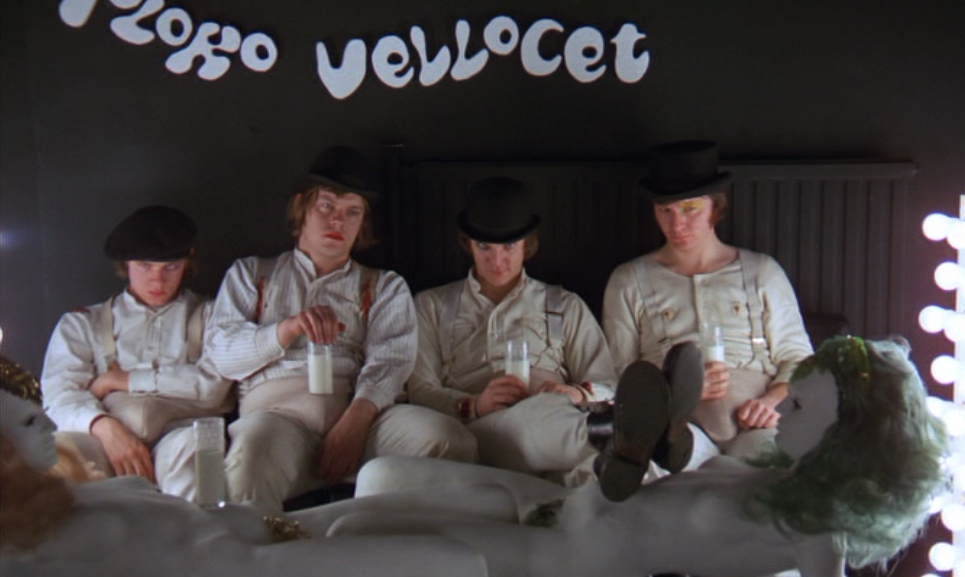A Clockwork Orange (Stanley Kubrick, 1971): UK/USA
Reviewed by Barbara Rowland. Viewed at the Santa Barbara International Film Festival 2012.

“There was me, that is Alex, and my three droogs, this Pete, Georgie and Dim, and we sat in the Korova Milkbar trying to make up our rassoodocks what to do with the evening. The Korova milkbar sold milk-plus, milk plus vellocet or synthemesc or drencrom, which is what we were drinking. This would sharpen you up and make you ready for a bit of the old ultra-violence.”
A Clockwork Orange is arguably one of the most brilliant and controversial films of it’s time. The most important thing to remember while viewing this film is to keep an open mind. Famously directed by Stanley Kubrick (2001: A Space Odyssey, Full Metal Jacket) this 1971 cult classic defys genres and raptures the eye. A memorable performance by Malcom McDowell (Caligula, Halloween) captures attention and enhances believability. While contributing to it’s “cult” status, I eagerly awaited the opportunity to witness Clockwork on the silver screen. The restoration attached to it’s 40th anniversary was welcomed by an assortment of film goers during the 2012 Santa Barbara International Film Festival.
Setting the pace to adapt from novel (authored by Anthony Burgess) to film Clockwork starts by creatively introducting audiences to the gang of Droogs led by Alexander (Malcom McDowell). Armoured with the combination of drug laced Kurova milk the quartet of hooligans commit various criminal activities throughout the town. Abuse, rape, home invasion, theft are just the surface of nightly involvements. Accompianied by treasured Ludwig Van symphonies the ultra violence continues until leader Alex commits the accidental killing of a woman. Upset with the direction from their leader the gang abandons Alex leaving him to the brute embrace of the ghastly police. After time Alex discovers the newly created Ludavico technique which advertises a cure for violent tendencies but more importantly an early release from prison. Once charming his way into participating in the treatment Alex finds himself biting off more than he can chew.
While intense taboo subject matter weave in and out of frame, articulated narrative story telling maintains constancy throughout. The dialogue is rumored to be a combination of Slavic and Cockney rhyming slang. This not only adds to the many thematic layers within this film but also to the feel and look. We better understand the cult recognition by this and as the high contrast lighting spectrum splashes the screen. The use of color warps off scales, and defines pallets not only with sets but with wardrobe. The soundtrack created primarily by Walter(Wendy)Carlos recreates recognizable classical music and sets the unsettling mood of each scene. The artful choice of location bears little limitation to the film’s misplaced era and completes the stylization of each scene. The sets are so widely popular within the fan base that a Korova Milk Bar can be found perfectly placed upon a map. With this said however, I feel the details are the special touches that Kubrick and his fans cherished. For claimed followers of the film the recognition of the inexplicable, or rumored purposes for these special touches set this film aside. The creative use of mise-en-scene however, challenges the disgusted viewer and paves a path for further insight.
In summation, what else can be said about Clockwork that hasn’t already been posed? The acting, the sets, the dialogue, the music, make this film the piece of film history that it is today. I treasure this film within my own personal collection and was thrilled to see it as a part of the festival.
Haven’t seen it? Keep an open mind, expect the unexpected and it never hurts to use subtitles.
About this entry
You’re currently reading “A Clockwork Orange (Stanley Kubrick, 1971): UK/USA,” an entry on Student Film Reviews
- Published:
- 02.10.12 / 8pm
- Category:
- DVD, Films, Santa Barbara Film Festival 2012
7 Comments
Jump to comment form | comments rss [?] | trackback uri [?]